|
|
 |
Fiche d'espèce de Copépode |
|
|
Harpacticoida ( Ordre ) |
|
|
|
Euterpinidae ( Famille ) |
|
|
|
Euterpina ( Genre ) |
|
|
| |
Euterpina acutifrons (Dana, 1848) (F,M) | |
| | | | | | | Syn.: | Harpacticus acutifrons Dana, 1848;
Euterpe gracilis Claus, 1863 (p.110, figs.F,M);
Euterpe gracilis armata : T. Scott, 1894 b (p.93, figs.F);
Euterpe acutifrons : Giesbrecht, 1892 (p.555, 776, figs.F,M); Wolfenden, 1905 (1906) (p.1034, figs.F); Esterly, 1905 (p.212, figs.F,M); van Breemen, 1908 a (p.176, figs.F,M); Mori, 1929 (p.200, Figs.F); Farran, 1929 (p.211, 297); Mori, 1937 (1964 (p.117, figs.F,M); Yamazi, 1958 (p.154, Rem.); Shih & Young, 1995 (p.75) | | | | Ref.: | | | Thompson & Scott, 1903 (p.237, 258); A. Scott, 1909 (p.229, Rem.); Pesta, 1920 (p.629); Sars, 1921 (p.97, figs.F,M); Sewell, 1924 (p.836); Früchtl, 1924 b (p.106); Monard, 1928 (p.300, figs.F); Rose, 1929 (p.54); 1933 a (p.290, figs.F,M); Dakin & Colefax, 1933 (p.208); Sewell, 1933 (p.31); Farran, 1936 a (p.123); Mori, 1937 (1964) (p.117, figs.F,M); Sewell, 1940 (p.141); Dakin & Colefax, 1940 (p.106, figs.F,M); Wilson, 1942 a (p.186); Klie, 1943 a (n°4, p.3, figs.F,M); Sewell, 1947 (p.290); Lang, 1948 a (p.285, 1588, figs.F,M); Marques, 1951 (16); Carvalho, 1952 a (p.163, figs.F,M); Marques, 1955 (20); 1957 (p.44); Krishnaswamy, 1957 (p.14, Rem.); Marques, 1958 a (p.143); Tanaka, 1960 (p.92); M. Bernard, 1963 (p.35, figs. N, juv., Rem.); De Decker, 1964 (p.15, 22); Vilela, 1965 (p.18); Gonzalez & Bowman, 1965 (p.264, figs.F,M); Haq, 1965 (p.175, Development, dimorphism male); Saraswathy, 1966 (1967) (p.86); Dussart, 1967 (p.170, 171, figs.F,M); Vilela, 1968 (p.42); Ramirez, 1969 (p.100); Corral Estrada, 1970 (p.252); Björnberg, 1972 (Rem., N, figs.); Bradford, 1972 (p.50, figs.F); Razouls, 1972 (p.96, Annexe: p.141); Haq, 1972 (p.221, Rem.M); 1973 (p.23, Rem.M); Marques, 1973 (253); Chen & al., 1974 (p.69, figs.F); Goswami, 1976 (p.123, figs. N, Juv., F,M); Boxshall, 1979 (p.229, figs.F,M); Dawson & Knatz, 1980 (p.10, figs.F,M); Björnberg & al., 1981 (p.679, figs.F,M); Marques, 1982 (p.768); Sazhina, 1982 (Rem.N, fig.); 1985 (p.98,figs.N); Zheng Zhong & al., 1984 (1989) (p.271, figs.F,M); Stancyk & Moreira, 1988 (p.125, sexual dimorphism); Huys & Boxshall, 1991 (p.362, 385, 40); Kim & al., 1993 (p.271); Chihara & Murano, 1997 (p.957, Pl.208: F,M); Bradford-Grieve & al., 1999 (p.886, 968, figs.F,M); Al-Yamani & Prusova, 2003 (p.116, figs.F); Conway & al., 2003 (p.217, figs.F,M, Rem.); Boxshall & Halsey, 2004 (p. 299, p.300: figs.F,M); Conway, 2006 (p.24, copepodides 1-6, Rem.); Avancini & al., 2006 (p.131, Pl. 99, figs.F,M, Rem.); Ferrari & Dahms, 2007 (p.31, 32, Rem. N); Vives & Shmeleva, 2010 (p.106, figs.F,M, Rem.); Al-Yamani & al., 2011 (p.124, figs.F); Harvey J.B.J. & al., 2012 (p.60, Table 2, molecular sequences); Blanco-Bercial & al., 2014 (p.5: Rem.: problematical for barcoding) | 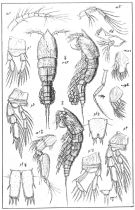 issued from : G.O. Sars in An Account of the Crustacea of Norway. Suppl. Vol. VII. Copepoda Supplement. Published by the Bergen Museum, 1921. [Pl. LXVII]. Female & Male.
|
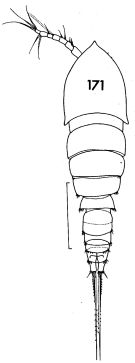 issued from : F.C. Ramirez in Contr. Inst. Biol. mar., Buenos Aires, 1969, 98. [p.98, Lam. XX, fig.171]. Female (from off Mar del Plata): 171, habitus (dorsal). Sale bar in mm: 0.2.
|
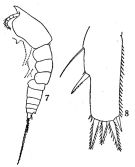 issued from : Q.-c Chen & S.-z. Zhang & C.-s. Zhu in Studia Marina Sinica, 1974, 9. [Pl.24, Figs.7-8]. Female (from China Seas): 7, habitus (lateral left side); 8, P5.
|
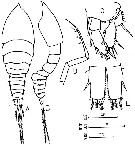 issued from : F.Y. Al-Yamani & I. Prusova in Common Copepods Northwestern Arabian Gulf : Identification Guide. Kuwait Institute for Scientific Research, 2003. [p.117, Fig.44]. Female: A, habitus (dorsal); B, idem (lateral left side); C, P1; D, Mxp; E, P5.
|
 issued from : G.A. Boxshall in Bull. Br. Mus. nat. Hist. (Zool.), 1979, 35 (3). [p.230, Fig.14, G-N]. Female: G, habitus (dorsal); H, A1; I, A2; J, P5. Male: K, A1; L, P1; M, P5; N, P6. Scales 0.1 mm unless otherwise indicated. Nota: The fine lateral setule present in the axil of the outer margin spine on P5 has been reported previously in both the male and female by several authors; this setule is not illustrated in either sex by Sars (1921) or in the male by Chappuis (1936) and Giesbrecht (1892), it is probable that the setule has been overlooked by the latter authors; it was even found to be present in both morphs of male studied by Haq (1965).
|
 issued from : C.O. Esterly in Univ. Calif. Publs Zool., 1905, 2 (4). [p.213, Fig.53]. As Euterpe acutifrons. Female (from San Diego Region): b, exopod of P4; d, P5. Male: a, habitus (lateral); c, P1; e, A1.
|
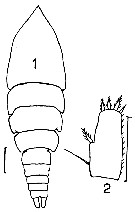 issued from : J.M. Bradford in Mem. N. Z. Oceonogr. Inst., 1972, 54. [p.52, Fig.15, (1-2]. Female (from Kaikoura, New Zealand): 1, habitus (dorsal; 2, P5. Scale bars: 0.1 mm.
|
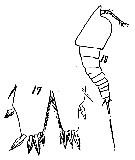 issued from : T. Mori in Zool. Mag. Tokyo, 1929, 41 (486-487). [Pl. VII, Figs.17-18]. As Euterpe acutifrons. Female (from Chosen Strait, Korea-Japan): 17, P5; 18, habitus (lateral).
|
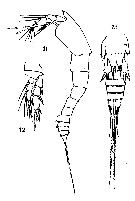 issued from : T. Mori in The Pelagic copepoda from the neighbouring waters of Japan, 1937 (1964). [Pl. 64, Figs.11-13]. Male: 11, habitus (lateral); 12, P4; 13, posterior division of body with P5 (ventral).
|
 Issued from : W. Giesbrecht in Systematik und Faunistik der Pelagischen Copepoden des Golfes von Neapel und der angrenzenden Meeres-Abschnitte. – Fauna Flora Golf. Neapel, 1892. Atlas von 54 Tafeln. [Taf.44 , Figs.19, 20, 21, 23, 24, 25, 28 ]. Female: habitus with egg-sec (dorsal); 20, A2; 21, anal segment and caudal rami (dorsal); 23, P5; 24, A1; 25, Mx1; 28, Mxp.
|
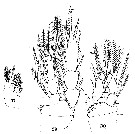 Issued from : W. Giesbrecht in Systematik und Faunistik der Pelagischen Copepoden des Golfes von Neapel und der angrenzenden Meeres-Abschnitte. – Fauna Flora Golf. Neapel, 1892. Atlas von 54 Tafeln. [Taf.44 , Figs.17, 29, 30 ]. Female: 17, Mx2; 29, P4; 30, P1.
|
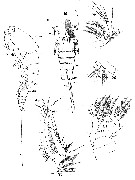 Issued from : W. Giesbrecht in Systematik und Faunistik der Pelagischen Copepoden des Golfes von Neapel und der angrenzenden Meeres-Abschnitte. – Fauna Flora Golf. Neapel, 1892. Atlas von 54 Tafeln. [Taf.44 , Figs.16, 18, 22, 26, 27, 31]. Male: 16, urosome (ventral); 18, habitus (lateral); 22, A2; 26, Md; 27, A1; 31, P1.
|
 issued from : A. Skovgaard & N. Daugbjerg in Protist, 2008, 159. [p.403, Fig.1 D]. Paradinium sp. (PaEu41) gonosphere attached to the urosome of its host E. acutifrons in NW Mediterranean Sea.
| | | | | Ref. compl.: | | | Gadeau de Kerville, 1894 (p.82); Rose, 1925 (p.152); Gurney, 1927 (p.167); Massuti Alzamora, 1942 (p.108, Rem.); Sewell, 1948 (p.394); Fleury, 1950 (p.47, fig.2); Grice, 1956 (p.56); Deevey, 1960 (p.5, Table II, annual abundance, Rem.: fig.18, 19); H. Schulz, 1961 (p.57); Fagetti, 1962 (p.41); Ganapati & Shanthakumari, 1962 (p.11, 16); Gaudy, 1962 (p.93, 99, Rem.: p.118) ; Giron-Reguer, 1963 (p.58); V.N. Greze, 1963 a (tabl.2); Gaudy, 1963 (p.31, Rem.); Björnberg, 1963 (p.71, Rem.); Unterüberbacher, 1964 (p.33); De Decker, 1964 (p.15, 22, 30); De Decker & Mombeck, 1964 (p.12); Bodo & al., 1965 (p.219, annual cycle); Shmeleva, 1965 b (p.1350, lengths-volume-weight relation); Neunes & Pongolini, 1965 (p.571, breeding, development time); Neto & Paiva, 1966 (p.36, Table III, annual cycle); Mazza, 1966 (p.73); Pavlova, 1966 (p.45); Chakroun, 1966 (p.67, Tableau); Ehrhardt, 1967 (p.742, geographic distribution, Rem.); Moreira & Vernberg, 1968 (p.282, metabolism); Delalo, 1968 (p.139); Harder, 1968 (p156, Table 1, behaviour vs. density discontinuity); Berdugo & Kimor, 1968 (p.448); El-Maghraby & Dowidar, 1970 (p.81); Dowidar & El-Maghraby, 1970 (p.268); Reeve, 1970 (p.894, Rem.: p.909); Nassogne, 1970 (p.333, rearing); Paulmier, 1971 (p.168); Deevey, 1971 (p.224); Valentin, 1972 (p.349, figs.9, 10, 15, 17, egg production); Binet & al., 1972 (p.68); Bainbridge, 1972 (p.61, Appendix Table I: vertical distribution vs. day/night); Nival & al., 1972 (p.63, respiration); Razouls S., 1972 b (p.2, respiration); Subbaraju & Krishnamurphy, 1972 (p.25, 26, Table 1: periods of abundance vs. India localities ); Apostolopoulou, 1972 (p.329, 376); Della Croce & al., 1972 (p.1, fig.2, Rem.); Björnberg, 1973 (p.370); Binet, 1973 (p.77); Desgouille, 1973 (p.1, 131, Rem.: p.138); S. Razouls, 1974 (147, oxygen rate); Vernberg & Moreira, 1974 (p.757, metabolism-temperature); Corral Estrada & Pereiro Muñoz, 1974 (tab.I); Palet, 1975 (p.660); Vives & al., 1975 (p.56, tab.II, III); Zismann & al., 1975 (p.59, prey); Gaudy, 1976 (p.77, fig.1, 8, Table I, II, III, production); Lakkis & Abboud, 1976 (p.81); Grindley, 1977 (p.341, Table 2); Zurlini & al., 1978 (p.59, egg production, development time); Comaschi Scaramuzza, 1978 (p.17); D'Apolito & Stancyk, 1979 (p.251, population dynamic); Dessier, 1979 (p.133, 201, 207); Chen Q-c, 1980 (p.795); Gallo, 1981 (p.847, Rem.: p.849); Castel & Courties, 1982 (p.417, Table II, fig.4, spatial & monthly distribution); Vives, 1982 (p.295); Kovalev & Shmeleva, 1982 (p.85); Moreira & al., 1982 (p.85, temperature-salinity effects); Moreira & al., 1983 (p.111, developmental stages); Dessier, 1983 (p.89, Tableau 1, Rem., %); Pieper & Holliday, 1984 (p.226, Fig.3); De Decker, 1984 (p.317, 351: chart); Scotto di Carlo & al., 1984 (p.1045); Lefèvre-Lehoërff & al., 1984 (p.131, annual variations); d'Elbée, 1984 (p.25, Fig.6); Moreira & McNamara, 1984 (p.298, annual variation, dimorphic male); Moraitou-Apostolopoulou, 1985 (p.303, occurrence/abundance in E Mediterranean Sea); Regner, 1985 (p.11, Rem.: p.40); Jansa, 1985 (p.108, Tabl.I, II, III, IV, V); Brinton & al., 1986 (p.228, Table 1); M. Lefèvre, 1986 (p.33, 40); Sciandra, 1986 (p.1149, population dynamic); Knatz, 1986 (p.81); Brylinski, 1986 (p.457, spatial variations); Valentin & al., 1986 (p.117, Table V); Boucher & al., 1987 (p.133, spatial distribution/physical structure); Comaschi Scaramuzza, 1987 (tab.1); Ceccherelli & al., 1987 (p.571, fig.5); Diouf & Diallo, 1987 (p.260); Lozano Soldevilla & al., 1988 (p.61); Jenkins, 1988 (p.233, Table 1, 2, fig.6); Krsinic & Vilicic, 1989 (p.12, tab.3); Carlotti & Sciandra, 1989 (p.225, , population dynamic, modelisation): Othman & al., 1990 (p.561, 564, Table 1); Mitra & al., 1990 (fig.3); Lindo, 1991 (tab.3); McKinnon, 1991 (p.471); Dai & al., 1991 (tab.1); Yoo, 1991 (tab.1); Jouffre & al., 1991 (p.489, lagoon); Carlotti & P. Nival, 1992 (p.233, growth & mortality); Seguin & al., 1993 (p.23); Kimmerer, 1993 (tab.2); Godhantaraman, 1994 (tab.5, 6, 7); Sautour, 1994 (p.113, grazing); Kouwenberg, 1994 (tab.1); Verheye & al., 1994 (p.155); Lopes, 1994 (tab.1); Lefèvre-Lehoërff & al., 1995 (p.269, annual hydroclimatic variations); Santos & Ramirez, 1995 (p.133, fig.2, 3); Böttger-Schnack, 1995 (p.93); 1996 (p.1088); Eskinazi-Sant'Anna & Tundisi, 1996 (tab.1,2); Hopcroft & Roff, 1996 (p.789, diel egg production); Guisande & al., 1996 (p.37, egg size/number and food concentration); Viñas & Gaudy, 1996 (p.307, Rem.); Webber & al., 1996 (tab.1); Böttger-Schnack, 1997 (p.410); Park & Choi, 1997 (Appendix); Sharaf & Al-Ghais, 1997 (tab.1); Noda & al., 1998 (p.55, Table 3, occurrence); Hure & Krsinic, 1998 (p.82, 103); Gilabert & Moreno, 1998 (tab.1,2); Alvarez-Cadena & al., 1998 (tab.1); Hopcroft & al., 1998 (tab.2); Lopes & al., 1998 (p.195, tab.2); Achuthankutty & al., 1998 (p.1, Table 2, seasonal abundance vs monsoon); McKinnon & Klumpp, 1998 (tab.1); Suarez-Morales & Gasca, 1998 a (p.113); Harvey & al., 1999 (p.1, 49: Appendix 5, in ballast water vessel); Siokou-Frangou, 1999 (p.478); El-Serehy, 1999 (p.172, Table 1, occurrence); Lavaniegos & Gonzalez-Navarro, 1999 (p.239, Appx.1); Ueda & al., 2000 (tab.1); Fernandez-Alamo & al., 2000 (p.1139, Appendix); Suarez-Morales & al., 2000 (p.751, tab.1); Alvarez-Silva & Gomez-Aguirre, 2000 (p.163: tab.2); El-Sherif & Aboul Ezz, 2000 (p.61, Table 3: occurrence); Seridji & Hafferssas, 2000 (tab.1); Sautour & al., 2000 (p.531, Table II, abundance); Moraitou-Apostolopoulou & al., 2000 (tab.I); Plounevez & Champalbert, 2000 (p.175, Table III, IV, V, abundance vs fish); Fransz & Gonzalez, 2001 (p.255, tab.1); Ara, 2001 (p.177); 2001 b (p.121); El-Serehy & al., 2001 (p.116, Table 1, 3, 4: abundance vs transect in Suez Canal); Calbet & al., 2001 (p.319, Fig.7); Zerouali & Melhaoui, 2002 (p.91, Tableau I, figs.5, 11); Bressan Moro, 2002 (tab.2); Dunbar & Webber, 2003 (tab.1); Bode & al., 2003 (p.85, Table 1, abundance); Vukanic, 2003 (p.139, tab.1); McKinnon & al., 2003 (p.105, tab.1); Vieira & al., 2003 (p.S163, Table 2, abundance); Titelman & Kiørboe, 2003 a (p.137, nauplius behaviour); Diaz & al., 2003 (p.213, reproduction vs diet); Shimode & Shirayama, 2004 (tab.2); Hsieh & al., 2004 (p.398, tab.1, p.399, tab.2); Rezai & al., 2004 (p.486, tab.2, 3, abundance, Rem.); Daly Yahia & al., 2004 (p.366, fig.4, tab.1); Lan & al., 2004 (p.332, tab.1); Ara, 2004 (p.179, figs. 3,4,5); Marrari & al., 2004 (p.667, tab.1); Gallienne & al., 2004 (p.5, tab.3); CPR, 2004 (p.64, fig.195); Lakkis & al., 2005 (p.152); Baker & al., 2005 (tabl.); Alvarez-Silva & al., 2005 (p.39); Uriarte & Villate, 2005 (p.863, tab.I); Costa & al., 2005 (p.177, Rem.: feeding); Obuid Allah & al., 2005 (p.123, occurrence % vs metal contamination); Zuo & al., 2006 (p.164: tab.1); Isari & al., 2006 (p.241, tab.II); Marques & al., 2006 (p.297, tab.III); Hwang & al., 2006 (p.943, tabl. I); Rakhesh & al., 2006 (p.93, Table 2, spatial distribution); Sterza & Fernades, 2006 (p.95, Table 1, occurrence); Dias & Araujo, 2006 (p.77, Rem., chart); Mageed, 2006 (p.171, Table 4); Lopez-Ibarra & Palomares-Garcia, 2006 (p.63, Tabl. 1, seasonal abundance vs El-Niño); Zervoudaki & al., 2006 (p.149, Table I); Papastephanou & al., 2006 (p.3078, Table 3); Albaina & Irigoien, 2007 (p.435: Tab.1); Zakaria, 2007 (p.238, Table 2, spatial distribution); Zakaria & al., 2007 (p.52, Rem.: p.58, Table 1, vs Salinity); Valdés & al., 2007 (p.104: tab.1); Khelifi-Touhami & al., 2007 (p.327, Table 1); Busatto, 2007 (p.26, Tab.2); Leandro & al., 2007 (p.215); McKinnon & al., 2008 (p.844: Tab.1, fig.7); Cabal & al., 2008 (289, Table 1); Morales-Ramirez & Suarez-Morales, 2008 (p.524); Ayon & al., 2008 (p.238, Table 4: Peruvian samples); Fernandes, 2008 (p.465, Tabl.2); Rossi, 2008 (p.90: Tableau XII); Rakhesh & al., 2008 (p.154, abundance vs stations); Tseng L.-C. & al., 2008 (p.153, fig.5, Table 2, occurrence vs geographic distribution, indicator species); Ohtsuka & al., 2008 (p.115, Table 4, 5, Rem.: in Mizushima and Kitakyushu Harbors); Muelbert & al., 2008 (p.1662, Table 1); Skovgaard & Daugbjerg, 2008 (p.401, fig.1 D, parasited by Paradinium); Miyashita & al., 2009 (p.815, Tabl.II); Magalhaes & al., 2009 (p.187, Table 1, %); Brylinski, 2009 (p.253: Tab.1, p.257: Rem.); Hafferssas & Seridji, 2010 (p.353, Table 2); Eloire & al., 2010 (p.657, Table II, temporal variability); Lidvanov & al., 2010 (p.356, Table 3); Drira & al., 2010 (p.145, Tanl.2); Cornils & al., 2010 (p.2076, Table 3); Hernandez-Trujillo & al., 2010 (p.913, Table 2); Mazzocchi & Di Capua, 2010 (p.430); Hafferssas & al., 2010 (p.1281, Table III, abundance vs spatial distribution); Medellin-Mora & Navas S., 2010 (p.265, Tab. 2); Fazeli & al., 2010 (p.153, Table 1); W.-B. Chang & al., 2010 (p.735, Table 2, abundance); Isinibilir, 2010 (p.233, abundance %); Nowaczyk & al;, 2011 (p.2159, Table 2); Bollens & al., 2011 (p.1358, Table III, fig.6); El-Sherbiny & al., 2011 (p.837, seasonal abundance), Ventham, 2011 (p.50); Maiphae & Sa-ardrit, 2011 (p.641, Table 2, 3, Rem.); Van Magris & al., 2011 (p.260, abundance, interannual variability); Moscatello & al., 2011 (p.80, Table 4); Chew & Chong, 2011 (p.127, fig.4, 5, Table 2, 3, abundance vs location); Zhang G.-T. & Wong, 2011 (p.277, fig.6, 7, 8, abundance, indicator); Tseng L.-C. & al., 2011 (p.47, Table 2, occurrences vs mesh sizes); Selifonova, 2011 a (p.77, Table 1, alien species in Black Sea); S.C. Marques & al., 2011 (p.59, Table 1); Kâ & Hwang, 2011 (p.155, Table 3: occurrence %); Padovani & al., 2011 (p.205, Table 1, 2, abundance, predation); Mazzocchi & al., 2011 (p.1163, fig.6, long-term time-series 1984-2006); Isari & al., 2011 (p.51, Table 2, abundance vs distribution); Costa R.G. da & al;, 2011 (p.364, Table 1, seasonal occurrence); Pinheiro & al., 2011 (p.425, abundance vs season); Fileman & al., 2011 (p.403, abundance vs bloom condition); Ali & al., 2011 (p.601, fig.13, abundance vs tidal); Beltrao & al., 2011 (p.47, Table 1, density vs time); Chen M. & al., 2011 (p.1075, Fig.8, annual abundance variation); Tseng L.-C. & al., 2011 (p.239, Table 3, abundance %); Mazzocchi & al., 2012 (p.135, annual abundance 1984-2006); Ginderdeuren & al., 2012 (p.3, Table 1); Delpy & al., 2012 (p.1921, Table 2); Shiganova & al., 2012 (p.61, Table 4); Glushko & Lidvanov, 2012 (p.138, Tableau 1); Johan & al., 2012 (2013) (p.1, Table 1); Uysal & Shmeleva, 2012 (p.909, Table I); Salah S. & al., 2012 (p.155, Tableau 1); DiBacco & al., 2012 (p.483, Table S1, ballast water transport); Zizah & al., 2012 (p.79, Tableau I, Rem.: p.86, 89); Miloslavic & al., 2012 (p.165, Table 2, transect distribution); Vidjak & al., 2012 (p.243, Rem.: p.253); Aubry & al., 2012 (p.125, table 3, fig. 8 b, interannual variation); Jean & al., 2012 (p.12, Table 3, protein vs environmental metal stress); Nikolioudakis & al., 2012 (p.173, Table 2: Ivelv's selectivity index); Camus & Zeng, 2012 (p.1159, sex ratio vs diet, survival development); Johan & al., 2012 (p.647, Table 1, 2, fig.2, salinity range); Costa & al., 2012 (p.75, ingestion, filtration rate vs toxic algae); Gonçalves & al., 2012 (p.321, abundance vs climatic variability); Menéndez & al., 2012 (p.389, Table 1: seasonal abundance); Lavaniegos & al., 2012 (p. 11, Table 1, fig.3, seasonal abundance, Appendix); Almeida LR. & al., 2012 (p.13, Table 1, abundance); Rekik & al., 2012 (p.336, Table 1, abundabce); Gubanova & al., 2013 (in press, p.4, Table 2); Belmonte & al., 2013 (p.222, Table 2, abundance vs stations); in CalCOFI regional list (MDO, Nov. 2013; M. Ohman, comm. pers.); Tachibana & al., 2013 (p.545, Table 1, seasonal change 2006-2008); Melo Jùnior & al., 2013 (p.363, Table 2, egg production); Rakhesh & al., 2013 (p.7, Table 1, 4, abundance vs stations); Varadharajan & Soundarapandian, 2013 (p.2: occurrence vs stations); Jagadeesan & al., 2013 (p.27, Table 3, 6, fig.11, seasonal variation); Anjusha & al., 2013 (p.40, Table 3, abundance & feeding behavior); Terbiyik Kurt & Polat, 2013 (p.1163, Table 2, seasonal distribution); Sobrinho-Gonçalves & al., 2013 (p.713, Table 2, seasonal abundance vs environmental conditions); Alvarez-Silva & Torres-Alvarado, 2013 (p.241, Table1: seasonal abundance); Lidvanov & al., 2013 (p.290, Table 2, % composition); Hwang & al., 2014 (p.43, Appendix A: seasonal abundance); Bonecker & a., 2014 (p.445, Table II: frequency, horizontal & vertical distributions) ; Mazzocchi & al., 2014 (p.64, Table 4, abundance); Fierro Gonzalvez, 2014 (p.1, Tab. 3, 5, occurrence, abundance); Aboul Ezz & al., 2014 (p.283, Rem.: p.287); Zakaria, 2014 (p.3, Table 1, abundance vs 1960-2000); Zaafa & al., 2014 (p.67, Table I, occurrence); Dias & al., 2015 (p.483, Table 2, abundance, biomass, production); Nakajima & al., 2015 (p.19, Table 3: abundance); Rojas-Herrera & al., 2016 (p.40, Table 2: temporal abundance); Araujo & al., 2016 (p.1, Table 3, abundance, %); Zakaria & al., 2016 (p.1, Table 1, Rem.) ; Vidjak & al., 2016 (p.629, Rem.);Rosa J.C.L. & al., 2016 (p.71, Rem.); Benedetti & al., 2016 (p.159, Table I, fig.1, functional characters); Ben Ltaief & al., 2017 (p.1, Table III, Summer relative abundance); Marques-Rojas & Zoppi de Roa, 2017 (p.495, Table 1); Jerez-Guerrero & al., 2017 (p.1046, Table 1: temporal occurrence); Atique & al., 2017 (p.1, Table 1, fig.8, Rem.: p.11); El Arraj & al., 2017 (p.272, table 1, 2, spatial distribution); Ohtsuka & Nishida, 2017 (p.565, 578, Table 22.1, Fig.22.3: central station in Japanese waters); Benedetti & al., 2018 (p.1, Fig.2: ecological functional group); Abo-Taleb & Gharib, 2018 (p.139, Table 5, p.146, occurrence %); Chaouadi & Hafferssas, 2018 (p.913, Table II: occurrence); Dias & al., 2018 a (p.189, Rem.: p.196); Richirt & al., 2019 (p.3, Table 1, fig.2, 3, 4, 5, abundance changes vs years 1998-2014, table 2: diversity index); Hure M. & al., 2018 (p.1, Table 2: correlations); Palomares-Garcia & al., 2018 (p.178, Table 1: occurrence); Acha & al., 2020 (p.1, Table 3: occurrence % vs ecoregions, Table 5: indicator ecoregions). | | | | NZ: | 17 | | |
|
Carte de distribution de Euterpina acutifrons par zones géographiques
|
| | | | | | | | | | | | | | |  issued from : C.T. Achuthankutty, N. Ramaiah & G. Padmavati in Pelagic biogeography ICoPB II. Proc. 2nd Intern. Conf. Final report of SCOR/IOC working group 93, 9-14 July 1995. Workshop Report No. 142, Unesco, 1998. [p.8, Fig.6]. issued from : C.T. Achuthankutty, N. Ramaiah & G. Padmavati in Pelagic biogeography ICoPB II. Proc. 2nd Intern. Conf. Final report of SCOR/IOC working group 93, 9-14 July 1995. Workshop Report No. 142, Unesco, 1998. [p.8, Fig.6].
Salinity ranges for E. acutifrons in coastal and estuarine waters of Goa (India).
Shaded area indicates the range of higher abundance. |
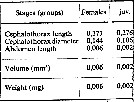 issued from : A.A. Shmeleva in Bull. Inst. Oceanogr., Monaco, 1965, 65 (n°1351). [Table 6: 41]. Euterpina acutifrons (from South Adriatic). issued from : A.A. Shmeleva in Bull. Inst. Oceanogr., Monaco, 1965, 65 (n°1351). [Table 6: 41]. Euterpina acutifrons (from South Adriatic).
Dimensions, volume and Weight wet. Means for 50-60 specimens. Volume and weight calculated by geometrical method. Assumed that the specific gravity of the Copepod body is equal to 1, then the volume will correspond to the weight. |
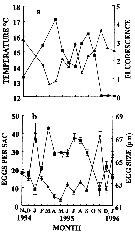 issued from : G. Guisande, J. Sanchez, I. Maneiro & A. Miranda in Mar. Ecol. Prog. Ser., 1996, 143. [p.39, Fig.1]. issued from : G. Guisande, J. Sanchez, I. Maneiro & A. Miranda in Mar. Ecol. Prog. Ser., 1996, 143. [p.39, Fig.1].
a: Mean temperature (black triangle) and food concentration (measured by fluorescence) (black square).
b: Values obtained (mean ± 2 SE) off egg size (black triangle) and number of eggs per sac (black square) in Euterpina acutifrons from the Ria de Vigo (NW Spain). |
 Issued from S. Razouls in XXIII rd Congress of Athens, 3-11 November 1972. [p.2]. Oxygen consumed by individual (adult) in the Banyuls Bay and equivalent carbon asked. Issued from S. Razouls in XXIII rd Congress of Athens, 3-11 November 1972. [p.2]. Oxygen consumed by individual (adult) in the Banyuls Bay and equivalent carbon asked.
(1) Hydrological season in the stability period: Eté = Summer: 18-20 °C; Hiver = Winter: 13-10°C.
Espèces = species; Saison = Season; Lg céph.= cephalothoracic length; an = individual. |
 Issued from : H.W. Neunes & G.-F. Pongolini in Nature, 1965, 6. [p.572, Table 1]. Issued from : H.W. Neunes & G.-F. Pongolini in Nature, 1965, 6. [p.572, Table 1].
Duration of larval stages of Euterpina acutifrons in single culture at 18°C; individuals collected in the Ligurian Sea (La Spezia Laboratory)
The average time for the completion of larval development (egg to adult) is between 17 and 18 days. This is not very different from records of other copepod species reared under similar conditions. If we assume a period of about 3 days for the time between emergence as an adult and hatching of its first eggs, a generation of Euterpina, under the conditions described, averages 20-21 days.
Natural sea-water served as basis for the culture media. EDTA in a concentration of 37 mg/l (= 10-4 mol.) was added as a complexing agent. As antibiotics, penicillin and streptomycin were used alternately. A suspension of a mixture of the flagellates and diatom was added as food. Bacterial growth was determined. |
| | | | Loc: | | | Cosmopolite (coastal & neritic): Agulhas Bank, South Africa (off Cape of Good Hope, E & W), Saldanha, Namibia, Angola, Baia Farta, Congo, G. of Guinea, Ivorian shelf, Guinea, Casamance, Dakar, Morocco-Mauritania, Cap Ghir, Canary Is., off Madeira, Argentina, Bahia Blanca, Peninsula Valdés, Mar del Plata, Uruguay (continental shelf), Brazil (S, Sao Paulo coast and estuaries, Ubatuba, Canaeia Lagoon, Rio de Janeiro, Guanabara Bay, Campos Basin, Cabo Frio, Vitoria Bay, Vitoria-Cabo de Sao Tomé, Guarairas Lagoon, Mucuri estuary, Guarau estuary, off Natal, Curuça estuary, Ajuruteua Beach, Caeté Estuary, Amazon), Caribbean, Caribbean Colombia, Bahia de Mochima (Venezuela), Jamaica (Kingston Harbour), Yucatan, lagunas de Veracruz, Porto-Rico, Cuba, off Bermuda, Florida, Delaware Bay, Portugal (Mondego estuary, Porto), Ria de Vigo, off Coruña, Bay of Biscay (Bilbao & Urdaibai estuaries, Gironde estuary, Arcachon Bay, La Pallice roadstead), Belon estuary, Celtic Sea, English Channel, Roscoff, Granville, Pas de Calais, North Sea, Skagerrak, Elbe (estuaire), Portugal, Ibero-moroccan Bay, W Tangier, Medit. (M'Diq, Alboran Sea, Habibas Is., Castellon, Baleares, Algiers, Banyuls, Thau Lagoon, Berre Lagoon, Marseille, Toulon Harbour, Gulf of Annaba, El Kala shelf, Villefranche-s-Mer, Ligurian Sea, Genoa, La Spezia, Tyrrhenian Sea, G. of Napoli, Strait of Messina, Gulf of Taranto, Taranto Harbour, Adriatic Sea, Vlora Bay, Venezzia, Po delta, Sibenik Harbour, Sfax, G. of Gabès, Tripoli, Ionian Sea, Aegean Sea, Thracian Sea, Iskenderun Bay, Marmara Sea, Black Sea, Lebanon Basin, Bay of Haïfa, W Egyptian coast, Alexandria, Abu Kir Bay, Bardawill Lagoon), Suez Canal (Km. 152, Kabret, Lake Timsah), Port Taufiq, Sharm-El-Sheikh, Taba, Hurghada, Safâga, Red Sea, Bab al Mandab, Gulf of Oman, Arabian Sea, Arabian Gulf (UAE coast, Kuwait), Madagascar, Rodrigues Is., Mascarene Basin, Seychelles Is., Cochin, Madras (coast), India (Goa, Saurashtra coast, S, Lawson's Bay, Porto Novo, Gulf of Mannar, Palk Bay, Pointcalimere-Manamelkudi, Godavari region, Kakinada Bay, Chilka Lake, W Bengal (Mandarmani creek), Bay of Bengal, Kurau River, Perai River estuary (Penang), Straits of Malacca, Sangga estuary, G. of Thailand, Indonesia-Malaysia, Sarawak: Bintulu coast, Thailand, Tioman Is., SW Celebes, Viet-Nam, Hong Kong, China Seas (Yellow Sea, East China Sea, South China Sea), Xiamen Harbour, N Yangtze Riv. estuary, Taiwan, S Korea, S Japan Sea, Japan, Honshu: Maizuru Bay, Kuchinoerabu Is., Kyushu: Shijiki Bay, Ariake Bay, Tanabe Bay, Tokyo Bay, Australia (G. of Carpentaria, North West Cape, Haughton River, Great Barrier, New South Wales, Melbourne, Ross River mouth), New Zealand (Kaikoura, Hauraki Gulf), Moorea Is. (lagoon), California (San Francisco Estuary, Monterey Bay, Los Angeles-Long Beach Harbors, San Pedro Bay, Tomales Bay), W & S Baja California (Bahia Magdalena, La Paz), Gulf of California, Coyuca lagoon (Guerrero), Zihuatanejo Bay, W Mexico, Acapulco Bay, G. of Tehuantepec, W Costa Rica, Bahia Cupica (Colombia), Galapagos, Peru, S Chile (53° S) | | | | N: | 420 | | | | Lg.: | | | (46) F: 0,73-0,53; M: 0,56-0,5; (66) F: 0,76-0,57; M: 0,67-0,47; (104) F: 0,8; M: 0,64; (109) F: 0,76-0,65; (116) F: 0,81; (132) F: 0,67; (138) F: 0,75-0,5; M: 0,56-0,5; (142) M: 0,73; (237) F: 0,85; (327) F: 0,69-0,58; M: 0,68-0,58; (332) F: 0,71-0,69; (336) F: 0,86-0,65; M: 0,65-0,61; (373) F: 0,83-0,5; M: 0,76-0,45; (388) F: 0,76-0,68; (432) F: 0,52; (433) F: 0,71-0,63; (434) F: 0,73-0,41; M: 0,65-0,36; (449) F: 0,75-0,5; M: 0,56-0,5; (530) F: 0,8; M: 0,6; (786) F: 0,82-0,58; M: 0,64-0,62; (858) G. of San Matias: F: 0,42-0,54; M: 0,30-0,38; Marseille: F: 0,38-0,50; M: 0,265-0,325; (920) : F: 0,65; (930) F: 0,7; (937) F: 0,68-0,72; (991) F: 0,50-0,75; M: 1,50-0,56; {F: 0,38-0,86; M: 0,36-0,76} | | | | Rem.: | L'espèce n'est que très exceptionnellement observée au large (comme par exemple jusque dans Algulhas Basin par 44° S ayant pour origine les côtes d'Afrique du Sud).
Non Antarct et Arct.;
Curieusement, je n’ai pu trouver (CR) de références concernant les côtes Nord-est de l’amérique du nord.
L'espèce est très abondante tout au long du Canal de Suez.
Voir aussi les remarques en anglais | | | Dernière mise à jour : 28/10/2022 | |
|
|
 Toute utilisation de ce site pour une publication sera mentionnée avec la référence suivante : Toute utilisation de ce site pour une publication sera mentionnée avec la référence suivante :
Razouls C., Desreumaux N., Kouwenberg J. et de Bovée F., 2005-2025. - Biodiversité des Copépodes planctoniques marins (morphologie, répartition géographique et données biologiques). Sorbonne Université, CNRS. Disponible sur http://copepodes.obs-banyuls.fr [Accédé le 05 janvier 2026] © copyright 2005-2025 Sorbonne Université, CNRS
|
|
 |
 |



















